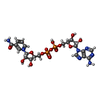+ データを開く
データを開く
- 基本情報
基本情報
| 登録情報 | データベース: PDB / ID: 4lcj | ||||||
|---|---|---|---|---|---|---|---|
| タイトル | CtBP2 in complex with substrate MTOB | ||||||
 要素 要素 | C-terminal-binding protein 2 | ||||||
 キーワード キーワード | OXIDOREDUCTASE/OXIDOREDUCTASE SUBSTRATE / Rossmann Fold / Transcriptional Corepressor / D-isomer 2-hydroxyacid dehydrogenase / OXIDOREDUCTASE-OXIDOREDUCTASE SUBSTRATE complex | ||||||
| 機能・相同性 |  機能・相同性情報 機能・相同性情報positive regulation of retinoic acid receptor signaling pathway / Signaling by TCF7L2 mutants / Repression of WNT target genes / oxidoreductase activity, acting on the CH-OH group of donors, NAD or NADP as acceptor / Sensory processing of sound by inner hair cells of the cochlea / white fat cell differentiation / transcription repressor complex / viral genome replication / transcription corepressor binding / transcription coregulator binding ...positive regulation of retinoic acid receptor signaling pathway / Signaling by TCF7L2 mutants / Repression of WNT target genes / oxidoreductase activity, acting on the CH-OH group of donors, NAD or NADP as acceptor / Sensory processing of sound by inner hair cells of the cochlea / white fat cell differentiation / transcription repressor complex / viral genome replication / transcription corepressor binding / transcription coregulator binding / NAD binding / transcription corepressor activity / DNA-binding transcription factor binding / transcription coactivator activity / negative regulation of cell population proliferation / negative regulation of DNA-templated transcription / synapse / regulation of transcription by RNA polymerase II / protein kinase binding / protein-containing complex binding / negative regulation of transcription by RNA polymerase II / positive regulation of transcription by RNA polymerase II / identical protein binding / nucleus 類似検索 - 分子機能 | ||||||
| 生物種 |  Homo sapiens (ヒト) Homo sapiens (ヒト) | ||||||
| 手法 |  X線回折 / X線回折 /  シンクロトロン / シンクロトロン /  分子置換 / 解像度: 2.86 Å 分子置換 / 解像度: 2.86 Å | ||||||
 データ登録者 データ登録者 | Hilbert, B.J. / Schiffer, C.A. / Royer Jr., W.E. | ||||||
 引用 引用 |  ジャーナル: Febs Lett. / 年: 2014 ジャーナル: Febs Lett. / 年: 2014タイトル: Crystal structures of human CtBP in complex with substrate MTOB reveal active site features useful for inhibitor design. 著者: Hilbert, B.J. / Grossmann, S.R. / Schiffer, C.A. / Royer, W.E. | ||||||
| 履歴 |
|
- 構造の表示
構造の表示
| 構造ビューア | 分子:  Molmil Molmil Jmol/JSmol Jmol/JSmol |
|---|
- ダウンロードとリンク
ダウンロードとリンク
- ダウンロード
ダウンロード
| PDBx/mmCIF形式 |  4lcj.cif.gz 4lcj.cif.gz | 491.8 KB | 表示 |  PDBx/mmCIF形式 PDBx/mmCIF形式 |
|---|---|---|---|---|
| PDB形式 |  pdb4lcj.ent.gz pdb4lcj.ent.gz | 400.4 KB | 表示 |  PDB形式 PDB形式 |
| PDBx/mmJSON形式 |  4lcj.json.gz 4lcj.json.gz | ツリー表示 |  PDBx/mmJSON形式 PDBx/mmJSON形式 | |
| その他 |  その他のダウンロード その他のダウンロード |
-検証レポート
| アーカイブディレクトリ |  https://data.pdbj.org/pub/pdb/validation_reports/lc/4lcj https://data.pdbj.org/pub/pdb/validation_reports/lc/4lcj ftp://data.pdbj.org/pub/pdb/validation_reports/lc/4lcj ftp://data.pdbj.org/pub/pdb/validation_reports/lc/4lcj | HTTPS FTP |
|---|
-関連構造データ
- リンク
リンク
- 集合体
集合体
| 登録構造単位 | 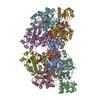
| ||||||||
|---|---|---|---|---|---|---|---|---|---|
| 1 | 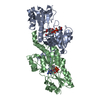
| ||||||||
| 2 | 
| ||||||||
| 3 | 
| ||||||||
| 4 | 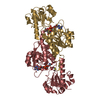
| ||||||||
| 単位格子 |
|
- 要素
要素
| #1: タンパク質 | 分子量: 38519.828 Da / 分子数: 8 / 断片: UNP residues 31-362 / 由来タイプ: 組換発現 / 由来: (組換発現)  Homo sapiens (ヒト) / 遺伝子: CTBP2 / プラスミド: pET28A / 発現宿主: Homo sapiens (ヒト) / 遺伝子: CTBP2 / プラスミド: pET28A / 発現宿主:  #2: 化合物 | ChemComp-NAD / #3: 化合物 | ChemComp-KMT / #4: 水 | ChemComp-HOH / | |
|---|
-実験情報
-実験
| 実験 | 手法:  X線回折 / 使用した結晶の数: 1 X線回折 / 使用した結晶の数: 1 |
|---|
- 試料調製
試料調製
| 結晶 | マシュー密度: 2.63 Å3/Da / 溶媒含有率: 53.25 % |
|---|---|
| 結晶化 | 温度: 298 K / 手法: 蒸気拡散法, ハンギングドロップ法 / pH: 7 詳細: 200 mM potassium nitrate, 15-20% PEG 3350, 100 mM bis tris propane, pH 7.0, VAPOR DIFFUSION, HANGING DROP, temperature 298K |
-データ収集
| 回折 | 平均測定温度: 100 K | |||||||||||||||||||||||||||||||||||||||||||||||||||||||||||||||||||||||||||||
|---|---|---|---|---|---|---|---|---|---|---|---|---|---|---|---|---|---|---|---|---|---|---|---|---|---|---|---|---|---|---|---|---|---|---|---|---|---|---|---|---|---|---|---|---|---|---|---|---|---|---|---|---|---|---|---|---|---|---|---|---|---|---|---|---|---|---|---|---|---|---|---|---|---|---|---|---|---|---|
| 放射光源 | 由来:  シンクロトロン / サイト: シンクロトロン / サイト:  APS APS  / ビームライン: 14-BM-C / 波長: 0.99 Å / ビームライン: 14-BM-C / 波長: 0.99 Å | |||||||||||||||||||||||||||||||||||||||||||||||||||||||||||||||||||||||||||||
| 検出器 | タイプ: ADSC QUANTUM 315 / 検出器: CCD / 日付: 2011年6月30日 | |||||||||||||||||||||||||||||||||||||||||||||||||||||||||||||||||||||||||||||
| 放射 | モノクロメーター: Bent Ge(111) monochromator / プロトコル: SINGLE WAVELENGTH / 単色(M)・ラウエ(L): M / 散乱光タイプ: x-ray | |||||||||||||||||||||||||||||||||||||||||||||||||||||||||||||||||||||||||||||
| 放射波長 | 波長: 0.99 Å / 相対比: 1 | |||||||||||||||||||||||||||||||||||||||||||||||||||||||||||||||||||||||||||||
| Reflection | 冗長度: 4.1 % / Av σ(I) over netI: 13.24 / 数: 298092 / Rmerge(I) obs: 0.093 / Χ2: 1 / D res high: 2.86 Å / D res low: 50 Å / Num. obs: 73374 / % possible obs: 99.4 | |||||||||||||||||||||||||||||||||||||||||||||||||||||||||||||||||||||||||||||
| Diffraction reflection shell |
| |||||||||||||||||||||||||||||||||||||||||||||||||||||||||||||||||||||||||||||
| 反射 | 解像度: 2.86→50 Å / Num. all: 73837 / Num. obs: 73374 / % possible obs: 99.4 % / Observed criterion σ(I): -3 / 冗長度: 4.1 % / Rmerge(I) obs: 0.093 / Χ2: 0.999 / Net I/σ(I): 10 | |||||||||||||||||||||||||||||||||||||||||||||||||||||||||||||||||||||||||||||
| 反射 シェル |
|
-位相決定
| 位相決定 | 手法:  分子置換 分子置換 | |||||||||
|---|---|---|---|---|---|---|---|---|---|---|
| Phasing MR | Model details: Phaser MODE: MR_AUTO
|
- 解析
解析
| ソフトウェア |
| |||||||||||||||||||||||||||||||||||||||||||||||||||||||||||||||||||||||||||||||||||||||||||||||||||||||||||||||||||||||||||||||||||||||||||||||||||||||||||||||||||||||||||||||||||||||||||||
|---|---|---|---|---|---|---|---|---|---|---|---|---|---|---|---|---|---|---|---|---|---|---|---|---|---|---|---|---|---|---|---|---|---|---|---|---|---|---|---|---|---|---|---|---|---|---|---|---|---|---|---|---|---|---|---|---|---|---|---|---|---|---|---|---|---|---|---|---|---|---|---|---|---|---|---|---|---|---|---|---|---|---|---|---|---|---|---|---|---|---|---|---|---|---|---|---|---|---|---|---|---|---|---|---|---|---|---|---|---|---|---|---|---|---|---|---|---|---|---|---|---|---|---|---|---|---|---|---|---|---|---|---|---|---|---|---|---|---|---|---|---|---|---|---|---|---|---|---|---|---|---|---|---|---|---|---|---|---|---|---|---|---|---|---|---|---|---|---|---|---|---|---|---|---|---|---|---|---|---|---|---|---|---|---|---|---|---|---|---|---|
| 精密化 | 構造決定の手法:  分子置換 / 解像度: 2.86→32.303 Å / Occupancy max: 1 / Occupancy min: 0.37 / SU ML: 0.36 / σ(F): 1.34 / 位相誤差: 28.7 / 立体化学のターゲット値: ML 分子置換 / 解像度: 2.86→32.303 Å / Occupancy max: 1 / Occupancy min: 0.37 / SU ML: 0.36 / σ(F): 1.34 / 位相誤差: 28.7 / 立体化学のターゲット値: ML
| |||||||||||||||||||||||||||||||||||||||||||||||||||||||||||||||||||||||||||||||||||||||||||||||||||||||||||||||||||||||||||||||||||||||||||||||||||||||||||||||||||||||||||||||||||||||||||||
| 溶媒の処理 | 減衰半径: 0.9 Å / VDWプローブ半径: 1.11 Å / 溶媒モデル: FLAT BULK SOLVENT MODEL | |||||||||||||||||||||||||||||||||||||||||||||||||||||||||||||||||||||||||||||||||||||||||||||||||||||||||||||||||||||||||||||||||||||||||||||||||||||||||||||||||||||||||||||||||||||||||||||
| 原子変位パラメータ | Biso max: 82.94 Å2 / Biso mean: 52.6922 Å2 / Biso min: 29.8 Å2 | |||||||||||||||||||||||||||||||||||||||||||||||||||||||||||||||||||||||||||||||||||||||||||||||||||||||||||||||||||||||||||||||||||||||||||||||||||||||||||||||||||||||||||||||||||||||||||||
| 精密化ステップ | サイクル: LAST / 解像度: 2.86→32.303 Å
| |||||||||||||||||||||||||||||||||||||||||||||||||||||||||||||||||||||||||||||||||||||||||||||||||||||||||||||||||||||||||||||||||||||||||||||||||||||||||||||||||||||||||||||||||||||||||||||
| 拘束条件 |
| |||||||||||||||||||||||||||||||||||||||||||||||||||||||||||||||||||||||||||||||||||||||||||||||||||||||||||||||||||||||||||||||||||||||||||||||||||||||||||||||||||||||||||||||||||||||||||||
| LS精密化 シェル | Refine-ID: X-RAY DIFFRACTION / Total num. of bins used: 26
|
 ムービー
ムービー コントローラー
コントローラー



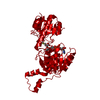





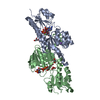


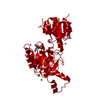

 PDBj
PDBj
